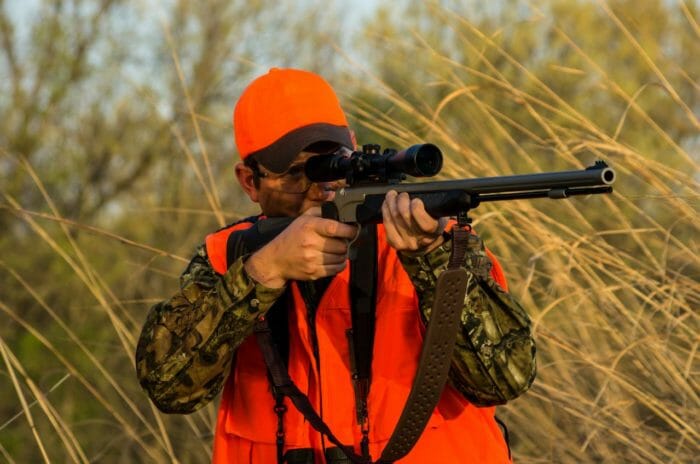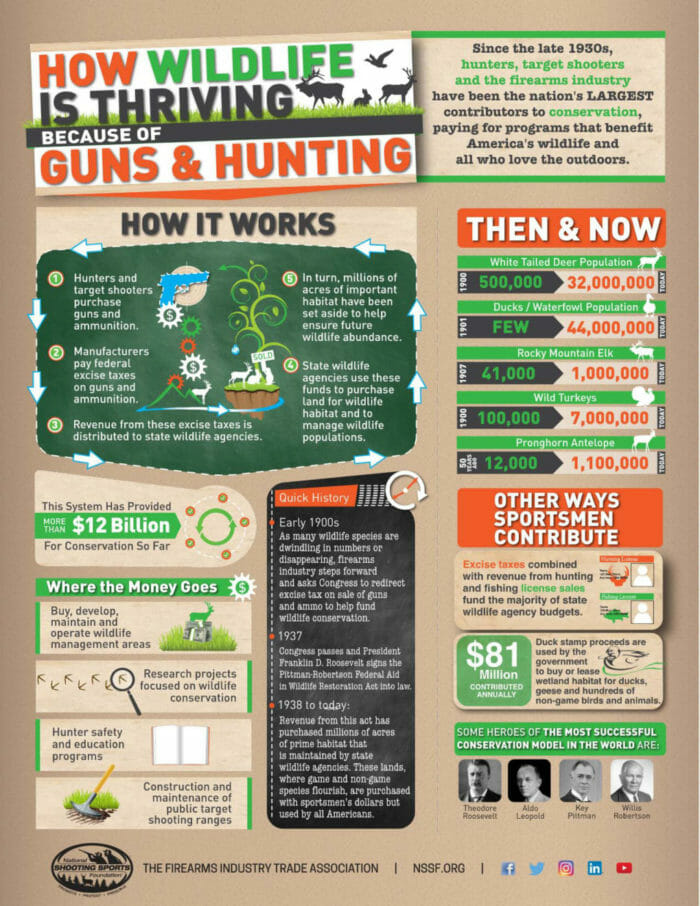Sportsmen and Sportswomen Generate Nearly $1 Billion in Conservation Funding
America’s sportsmen and sportswomen generated nearly $1 billion in excise taxes last year that support state conservation programs. Secretary of the Interior David Bernhardt today announced the disbursement of these funds, generated through excise taxes on hunting, shooting and fishing equipment and boat fuel to all 50 states and U.S. territories by the U.S. Fish and Wildlife Service (Service).
To date, the Service has distributed more than $22.9 billion in apportionments for state conservation and recreation projects. The recipient state wildlife agencies have matched these funds with approximately $7.6 billion throughout the years, primarily through hunting and fishing license revenues.
“Our conservation model is funded and supported by America’s hunters, shooters, anglers, boaters, and other outdoor enthusiasts. These stewards of conservation generated nearly a billion dollars last year alone and make our country's conservation legacy the envy of the world.”
Secretary of the Interior David Bernhardt
“When people pay taxes and fees, they want to know that their money is going to good use. These grants are a great example of fees paid by sportsmen and women being reinvested in opportunities for hunting, fishing, and other outdoor recreation opportunities. We are proud to work with the states and appreciate their efforts to keep public lands open for dispersed recreation where appropriate for those who need to get outside.”
Deputy Secretary of the Interior Katharine MacGregor
“These grants are the epitome of the great things that can happen when industry, hunters and anglers, and state and federal governments work together. As the administrator of these grants, the Fish and Wildlife Service is the linchpin in the circle of funding that arcs from the hunters and anglers generating these dollars as consumers, through the states as conservation managers, and back to hunters, anglers, and recreational users as beneficiaries, for improved hunting, fishing and conservation opportunities. It is a role we are honored to play.”
Service Director Aurelia Skipwith
Authorized by Congress through the Pittman-Robertson Federal Aid in Wildlife Restoration Act and Dingell-Johnson/Wallop-Breaux Federal Aid in Sport Fish Restoration Act, these funds support critical state conservation and outdoor recreation projects. The Wildlife and Sport Fish Restoration (WSFR) program, which the Service administers, has long been considered the foundation of fish and wildlife conservation in the United States.
State-by-state listings of the Service’s final apportionments of Wildlife Restoration, Sport Fish Restoration and State Wildlife Grant funds for the Fiscal Year 2020 and more information about the WSFR program are online.
In a related announcement, the Service is awarding $6.4 million in grants through its Competitive State Wildlife Grant (C-SWG) program. The funds help conserve and protect Species of Greatest Conservation Need and this year will be distributed to nine state fish and wildlife agencies. Several projects involve additional state fish and wildlife agencies working in partnership with these nine states.
“State fish and wildlife agencies play a crucial role in the conservation of America’s fish and wildlife and in delivering the promise of the North American Model of Wildlife Conservation. The Wildlife and Sportfish Restoration (WSFR) Program provides funding to states to protect and conserve our nation’s fish and wildlife heritage today and for generations to come. Strong and enduring partnerships are essential to our success, and there is no better example than the WSFR program.”
Secretary Kelly Hepler of South Dakota Game, Fish, and Parks and President of the Association of Fish and Wildlife Agencies
“Federal funding attributed to excise taxes constitute about a quarter of the annual revenue we reinvest on behalf of anglers and boaters here in Pennsylvania. Our allocation is largely driven by fishing license sales, and licenses purchased this spring will help to support trout stocking and other benefits enjoyed all year long across the Commonwealth. To increase convenience, we have made it easier than ever for anglers to go online, get their license and display it on their phone.”
Pennsylvania Fish and Boat Commission Executive Director Tim Schaeffer
“Pittman-Robertson and Dingell-Johnson funds coupled with sporting licenses are the lifeblood of state fish and wildlife agencies. These funds - generated solely by sportsmen and women - often account for 80% or more of state fish and wildlife agency revenue and are critically important to ensuring the completion of on-the-ground conservation, research and access projects. CSF applauds the Department of the Interior and the U.S. Fish and Wildlife Service for promptly distributing these ‘user pays-public benefits’ funds in a timely manner.”
Congressional Sportsmen’s Foundation (CSF) President Jeff Crane
“The sportfishing industry is proud to support the Sport Fish Restoration and Boating Trust Fund through excise taxes on fishing equipment. We appreciate the Secretary’s leadership in releasing these important grants that are used to help fund essential conservation and recreational fishing participation efforts throughout the United States."
American Sportfishing Association President Glenn Hughes
“The firearm and ammunition industry is a longtime and proud contributor to the Pittman-Robertson Wildlife Restoration Trust Fund. Our industry, in partnership with the Department of the Interior, plays a critical role in sustaining the North American Wildlife Conservation Model. That partnership demonstrates that investment in our wild animals and the habitats where they thrive pays dividends for tomorrow’s outdoorsmen and women. Firearm and ammunition makers had the foresight more than 80 years ago to recognize the importance of industry partnering with government, which has resulted in over $12.5 billion contributed to wildlife restoration since 1937. This has restored ducks to our skies and marshes, antelope to our plains, whitetail deer to our woods, opened millions of acres for public access for hunters and anglers and inspired conservationists for generations to come."
National Shooting Sports Foundation Senior Vice President and General Counsel Lawrence G. Keane
Conservation Totals
| State | FY 2020 Sportfish Restoration Grant Amount | FY 2020 State Wildlife Grants Amount | Total Amount of Grants Issued |
| Alabama | $6,265,821 | $14,178,844 | $20,444,665 |
| Alaska | $18,486,258 | $24,970,580 | $43,456,838 |
| American Somoa | $1,232,417 | $1,002,785 | $2,235,202 |
| Arizona | $7,585,390 | $16,781,416 | $24,366,806 |
| Arkansas | $5,402,877 | $9,550,317 | $14,953,194 |
| California | $17,703,209 | $19,541,968 | $37,245,177 |
| Colorado | $9,968,319 | $15,125,584 | $25,093,903 |
| Connecticut | $3,697,251 | $4,538,381 | $8,235,632 |
| Delaware | $3,697,251 | $3,647,470 | $7,344,721 |
| District of Columbia | $1,232,417 | $0 | $1,232,417 |
| Florida | $12,949,384 | $10,977,121 | $23,926,505 |
| Georgia | $8,556,437 | $17,471,530 | $26,027,967 |
| Guam | $1,232,417 | $1,002,785 | $2,235,202 |
| Hawaii | $3,697,251 | $3,678,793 | $7,376,044 |
| Idaho | $6,812,860 | $11,763,645 | $18,576,505 |
| Illinois | $6,864,057 | $12,392,851 | $19,256,908 |
| Indiana | $4,949,917 | $10,259,479 | $15,209,396 |
| Iowa | $4,830,208 | $8,678,088 | $13,508,296 |
| Kansas | $5,097,399 | $11,040,454 | $16,137,853 |
| Kentucky | $5,458,137 | $10,566,545 | $16,024,682 |
| Louisiana | $7,079,688 | $12,135,141 | $19,214,829 |
| Maine | $3,697,251 | $6,021,040 | $9,718,291 |
| Maryland | $3,697,251 | $6,038,257 | $9,735,508 |
| Massachusetts | $3,697,251 | $6,203,940 | $9,901,191 |
| Michigan | $11,455,775 | $17,997,307 | $29,453,082 |
| Minnesota | $13,330,473 | $17,592,212 | $30,922,685 |
| Mississippi | $4,138,531 | $9,092,443 | $13,230,974 |
| Missouri | $8,094,466 | $15,970,622 | $24,065,088 |
| Montana | $8,958,521 | $15,485,949 | $24,444,470 |
| N. Mariana Islands | $1,232,417 | $1,002,785 | $2,235,202 |
| Nebraska | $4,797,046 | $9,717,933 | $14,514,979 |
| Nevada | $5,266,576 | $10,502,549 | $15,769,125 |
| New Hampshire | $3,697,251 | $3,647,470 | $7,344,721 |
| New Jersey | $3,697,251 | $6,203,940 | $9,901,191 |
| New Mexico | $6,694,815 | $11,912,627 | $18,607,442 |
| New York | $8,201,051 | $15,687,703 | $23,888,754 |
| North Carolina | $11,146,945 | $16,626,074 | $27,773,019 |
| North Dakota | $4,347,341 | $8,460,411 | $12,807,752 |
| Ohio | $7,465,712 | $12,234,327 | $19,700,039 |
| Oklahoma | $8,236,479 | $15,668,006 | $23,904,485 |
| Oregon | $7,777,008 | $14,373,165 | $22,150,173 |
| Pennsylvania | $8,916,666 | $20,931,244 | $29,847,910 |
| Puerto Rico | $3,697,251 | $2,582,275 | $6,279,526 |
| Rhode Island | $3,697,251 | $3,647,470 | $7,344,721 |
| South Carolina | $4,863,676 | $7,812,139 | $12,675,815 |
| South Dakota | $4,741,945 | $10,145,967 | $14,887,912 |
| Tennessee | $7,524,049 | $17,067,040 | $24,591,089 |
| Texas | $18,486,258 | $27,527,049 | $46,013,307 |
| Utah | $6,826,986 | $11,246,261 | $18,073,247 |
| Vermont | $3,697,251 | $3,647,470 | $7,344,721 |
| Virgin Islands | $1,232,417 | $1,002,785 | $2,235,202 |
| Virginia | $5,352,890 | $10,715,423 | $16,068,313 |
| Washington | $7,234,683 | $11,466,414 | $18,701,097 |
| West Virginia | $3,697,251 | $6,173,284 | $9,870,535 |
| Wisconsin | $11,719,682 | $17,654,380 | $29,374,062 |
| Wyoming | $5,608,532 | $10,465,276 | $16,073,808 |
| TOTAL | $369,725,164 | $601,827,014 | $971,552,178 |


